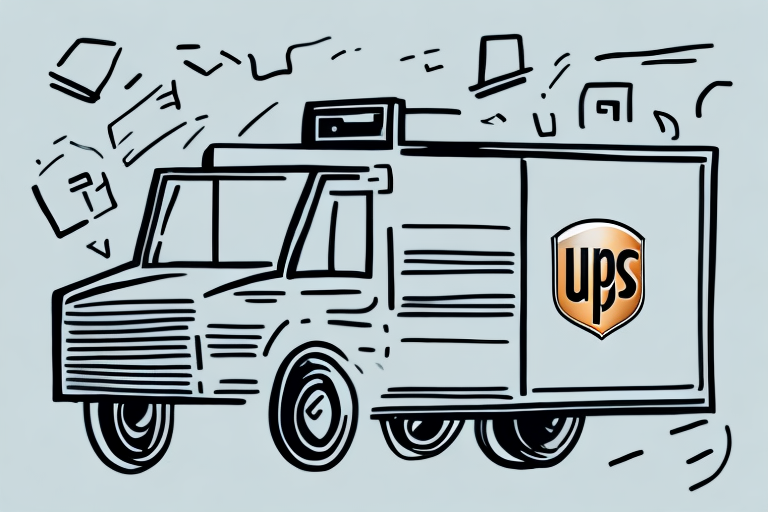Understanding UPS Shipping Rates for FBA Sellers
As an FBA seller, understanding UPS shipping rates is crucial to ensuring your business runs smoothly. With a strong reputation for reliable and efficient delivery, UPS is a popular choice among FBA sellers. In this article, we provide a comprehensive overview of UPS shipping rates for FBA sellers, including how UPS calculates shipping rates, the factors that affect those rates, and how to estimate shipping costs for your FBA shipment. We also offer tips for reducing your UPS shipping costs, discuss common mistakes to avoid when using UPS, and provide guidance on packaging your products for UPS shipments to Amazon fulfillment centers.
Why is UPS a Popular Choice for FBA Sellers?
UPS has a proven track record of delivering packages on time with minimal issues. According to UPS’s 2023 annual report, UPS handles millions of packages daily, ensuring timely deliveries that are critical for maintaining positive seller ratings on Amazon.
Additionally, UPS offers a wide range of shipping services, including both domestic and international options, which makes it an attractive choice for FBA sellers who need to reach a global customer base. UPS also provides various delivery confirmation and tracking services, beneficial for both buyers and sellers by enhancing transparency and trust.
Another reason UPS is favored by FBA sellers is their competitive pricing. UPS offers a variety of shipping options at different price points, allowing sellers to choose the most cost-effective option for their business. Moreover, UPS provides discounts for high-volume shippers, which can help FBA sellers save money on shipping costs over time. With reliable service and competitive pricing, it's no wonder why so many FBA sellers choose UPS as their preferred shipping carrier.
How Does UPS Calculate Shipping Rates for FBA Shipments?
UPS shipping rates are primarily based on several factors:
- Weight and Dimensions: Heavier and larger packages incur higher shipping costs.
- Distance: The farther the destination, the higher the rate, following UPS's zone-based pricing system.
- Service Level: Faster delivery options, such as expedited or next-day services, come at a premium.
- Additional Surcharges: Services like liftgate delivery, residential delivery, or special handling can add to the cost.
Moreover, the type of product being shipped can affect the rate. Items requiring special handling or packaging may incur additional fees. Higher-value items might also necessitate extra insurance or security measures, influencing the overall shipping cost.
UPS offers various tools and resources to help businesses calculate and manage their shipping costs. For instance, the UPS shipping calculator allows you to estimate shipping costs based on your package's weight, dimensions, and destination. Additionally, UPS provides discounts for businesses that ship frequently or in large volumes, as well as special rates for certain industries or types of shipments.
What Factors Affect UPS Shipping Rates for FBA Sellers?
Several factors can impact UPS shipping rates for FBA sellers:
- Package Weight and Size: Larger and heavier packages cost more to ship.
- Destination: International shipments are generally more expensive than domestic ones.
- Service Level: Expedited services such as Next Day Air are more costly than ground shipping.
- Additional Fees: Surcharges for services like liftgate delivery or residential delivery can increase costs.
- Type of Product: Special handling for fragile or high-value items can lead to higher shipping rates.
- Seasonality and Market Conditions: Shipping rates may rise during peak seasons like the holidays or fluctuate based on fuel prices.
Understanding these factors can help FBA sellers make informed decisions about their shipping strategies and manage costs effectively.
How to Estimate UPS Shipping Costs for Your FBA Shipment
UPS provides several tools and resources to help you estimate shipping costs for your FBA shipment:
- UPS Shipping Calculator: Utilize the UPS Shipping Calculator on their official website to input the weight, dimensions, and destination of your package for an estimated cost.
- Service Options: Compare different shipping options such as ground, air, and international to find the most cost-effective solution.
- Volume Discounts: Take advantage of UPS’s volume discounts if you regularly ship large quantities, reducing your overall shipping expenses.
By leveraging these tools, FBA sellers can accurately forecast their shipping expenses and choose the best shipping methods that align with their budget and delivery requirements.
Tips on Reducing Your UPS Shipping Costs as an FBA Seller
- Optimize Packaging: Use appropriately sized boxes to minimize weight and dimensional weight charges. Consider using lightweight packaging materials without compromising product safety.
- Consolidate Shipments: Combining multiple items into a single shipment can reduce the number of packages and overall shipping costs.
- Negotiate Rates: Engage in negotiations with UPS for better rates, especially if you have a high shipping volume.
- Leverage UPS Programs: Enroll in UPS programs like UPS My Choice or UPS Pro Services to access additional discounts and services.
- Automate Shipping Processes: Utilize shipping software that integrates with UPS to streamline operations and take advantage of bulk shipping rates.
Common Mistakes to Avoid When Using UPS for FBA Shipments
- Incorrect Labeling: Ensure all labels are accurate and clear to prevent delivery delays and additional charges.
- Improper Package Sizing: Use the right box size to avoid dimensional weight surcharges and protect your products during transit.
- Underestimating Shipping Costs: Calculate all potential fees and surcharges to avoid unexpected expenses.
- Neglecting Discounts: Failing to utilize available discounts for high-volume shipping can result in higher costs.
- Poor Packaging: Inadequate packaging can lead to damaged goods, returns, and increased shipping costs due to replacements.
- Incorrect Shipping Addresses: Double-check recipient addresses to prevent misdeliveries and additional shipping fees.
Avoiding these common mistakes can enhance your shipping efficiency, reduce costs, and improve your overall FBA business performance.
Comparing UPS with Other Courier Services for FBA Shipping
While UPS is a popular option for FBA shipping, it's essential to compare and contrast it with other courier services such as FedEx and USPS. Each courier has unique pricing structures, service offerings, and delivery timelines that may make them a better option in certain circumstances.
FedEx offers an extensive network of drop-off locations and a variety of shipping options, including same-day and international shipping. According to FedEx’s official website, their Express services can be ideal for urgent shipments, albeit often at a higher cost compared to UPS.
USPS is another option, particularly advantageous for smaller packages due to their competitive pricing on services like Priority Mail and Flat Rate boxes. While USPS may not offer the same level of tracking as UPS or FedEx, it can be a cost-effective choice for lightweight shipments. More information is available on the USPS shipping page.
Choosing the right courier depends on your specific needs, such as budget, delivery speed, package size, and destination. Evaluating these factors will help you determine the most suitable shipping partner for your FBA business.
Best Practices for Packaging Your Products for UPS Shipments to Amazon Fulfillment Centers
When shipping products to Amazon fulfillment centers via UPS, adhering to best packaging practices is essential to ensure your products arrive safely and undamaged. Here are some best practices:
- Use High-Quality Materials: Invest in sturdy boxes and reliable packing materials to protect your products during transit.
- Properly Cushion Items: Use sufficient padding such as bubble wrap or packing peanuts to prevent items from shifting inside the box.
- Seal Packages Securely: Use strong packing tape to seal all seams and edges of the box to deter handling damages.
- Label Correctly: Clearly label each package with the appropriate Amazon fulfillment center address and include any necessary barcodes or information.
- Avoid Overpacking: Use the right size box to avoid unnecessary weight and bulk, which can increase shipping costs and the risk of damage.
Following these practices not only ensures the safety of your products but also optimizes your shipping efficiency and reduces the likelihood of returns due to damaged goods.
Understanding the Different Types of UPS Shipping Services Available to FBA Sellers
UPS offers various shipping options to FBA sellers, each tailored to different needs and budgets:
- UPS Ground: Cost-effective for non-urgent shipments within the U.S., typically delivering within 1-5 business days.
- UPS 3 Day Select: Ensures delivery within three business days, suitable for moderately urgent shipments.
- UPS 2nd Day Air: Guarantees delivery by the end of the second business day, ideal for faster deliveries.
- UPS Next Day Air: Provides next-day delivery, perfect for time-sensitive shipments.
- UPS Worldwide Shipping: Offers international shipping with various service levels based on delivery speed and destination.
Before selecting a service, it's crucial to understand the delivery timelines, price points, and any restrictions associated with each option to make an informed decision that aligns with your business needs.
How to Choose the Right UPS Service Level for Your FBA Shipment
Choosing the right UPS service level for your FBA shipment involves analyzing several key factors:
- Delivery Timeline: Assess how quickly your products need to reach the Amazon fulfillment center and choose a service that meets this requirement.
- Package Size and Weight: Heavier and larger packages might be more cost-effective with ground shipping, whereas smaller, urgent packages could benefit from air services.
- Budget Constraints: Balance the need for speed with your budget by selecting a service level that offers the best value.
- Destination: Consider the proximity of the destination to choose the most efficient shipping method.
- Product Fragility: Fragile items may require expedited shipping to minimize handling time and reduce the risk of damage.
Additionally, consider consolidating shipments or opting for slower delivery options when possible to save on costs. For shipments to remote or hard-to-reach locations, faster service levels might be necessary to ensure timely delivery. Always review any special requirements or restrictions for your shipment to select the most appropriate UPS service level.
Tracking and Managing Your UPS Shipments as an FBA Seller
Utilizing UPS's tracking and management tools enables FBA sellers to monitor the progress of their deliveries and proactively address any potential issues. These tools contribute to a smooth customer experience by ensuring timely deliveries and reducing the likelihood of disputes or negative feedback.
One of the key benefits of using UPS's tracking and management tools is the ability to receive real-time updates on the status of your shipments. According to UPS's tracking services, you can view detailed information about each shipment, including delivery status, location, and estimated arrival times. This visibility allows you to anticipate delays and communicate effectively with your customers.
Additionally, UPS provides features such as automated notifications, custom reporting, and integration with shipping software, which streamline the management of your shipments. By leveraging these tools, FBA sellers can enhance their operational efficiency, ensure timely deliveries, and maintain high levels of customer satisfaction.
Dealing with Delivery Issues and Returns when Using UPS for FBA Shipments
Despite best efforts, delivery issues and returns can still occur. UPS offers several tools and services to address these challenges:
- Delivery Change Requests: Use the UPS Delivery Manager to request changes to the delivery address, delivery time, or to hold the package for pickup.
- Return Services: UPS Returns® Plus allows customers to print return labels and drop off packages at any UPS location, simplifying the return process.
- Claim Filing: In case of lost or damaged packages, file a claim through UPS to seek reimbursement or resolution.
One of the most common delivery issues FBA sellers face is package theft. To mitigate this, UPS offers the UPS My Choice service, which provides customers with tracking alerts and the ability to reroute deliveries, reducing the risk of theft.
Handling returns efficiently is also crucial. By utilizing UPS’s return services, FBA sellers can offer a hassle-free return experience, enhancing customer satisfaction and trust.
Overall, understanding and utilizing UPS's tools and services for managing delivery issues and returns is vital for maintaining smooth operations and ensuring customer satisfaction.
By comprehensively understanding UPS shipping rates, services, and best practices, FBA sellers can streamline their operations, reduce costs, and enhance overall efficiency and profitability. Implementing the tips and avoiding common mistakes discussed in this article will empower you to make informed decisions about your shipping needs and optimize your FBA business for success.




















